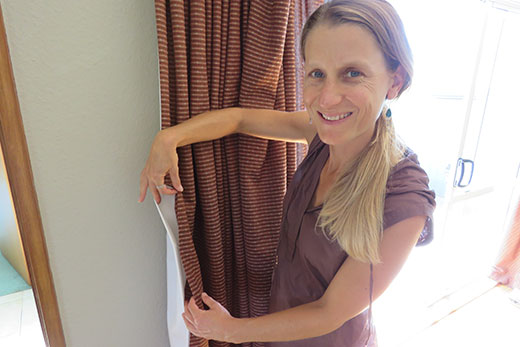This month, the Sustainable Backyards 2016 calendar included an event on Solar & Home Sustainability in Action.
Journalist Merle Foster wanted to know more – so Sustainability Options' development manager Jo Wills visited her Katikati home to undertake a free assessment and give advice on how to make her house a more sustainable asset.
Sustainability Options' development manager Jo Wills says full-length curtains with a backing are most successful at keeping warmth inside your home.
IN this second segment, Jo has just told merle her first item to address is the aluminium windows with full-length blinds.
I need curtains – full-length curtains made of a thick material and backed with a lining.
Jo says the two layers create an air gap which is an insulator and also helps to prevent the warm air movement from inside the room, escaping out through the windows. Apparently, one-layer thermal curtains don't have the same effect, nor do blinds.
Also, curtains should be hung slightly above the window frame and have a pelmet or a closed track to stop heat from escaping down behind the curtains. Hot air rises remember? And heat always looks for the quickest escape.
We also have a Kent fire in the dining room. But our lounge is separated from the dining room by doors, walls and corners, and heat doesn't turn corners very well so it will take a while to reach the lounge. But with curtains replacing the blinds in the lounge, natural passive heat coming in from the sun during the day will help to keep things toasty in winter.
However, the fire can warm the dining room and kitchen – and by installing a heat transfer kit I can feed the soul of a warm winter fire into the two front bedrooms.
Thoughts now whirl about how much curtains will cost. And they do cost. But you can pick up second-hand ones that meet the brief. You can hit a sale at Spotlight and make your own. Or invest in some from a curtain retailer – because I'm assured the heating-trapping benefits cost will outweigh the cost.
Same goes with the heat transfer kit – you can get DIY ones or pay for them to be installed. And you don't have to do it all at once. Prioritise one item – for me the curtains – and spend a winter to see how they work out. Add the transfer kit next winter.
But Jo says the main message is to get people understanding how their home works as a whole. Many little things round the home can be done which will together with the large projects make the home hum as an efficient power user and a sustainable asset. I hope this has got you thinking ahead of this winter.



0 comments
Leave a Comment
You must be logged in to make a comment.